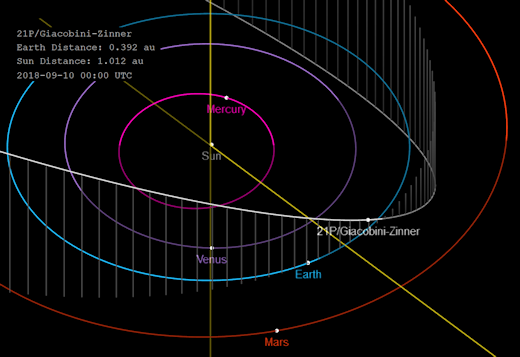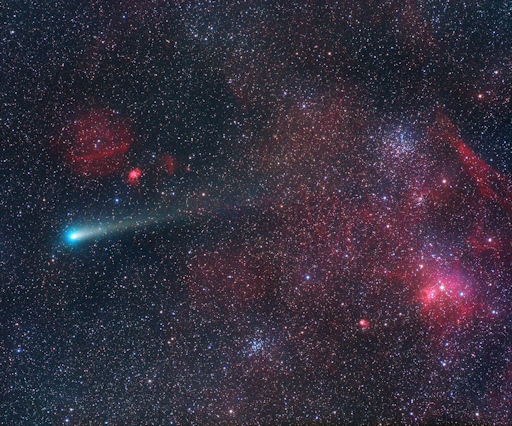GEOMAGNETIC STORM PREDICTED: NOAA forecasters have issued a watch for G2-class (moderately strong) geomagnetic storms on Sept. 11th. That’s when a fast-moving stream of solar wind is expected to hit Earth’s magnetic field. The gaseous material is flowing from a canyon-shaped hole in the sun’s atmosphere. During G2-class storms, auroras can appear in the United States from New York to Wisconsin to Washington state. Free: Aurora Alerts.
GREEN COMET MAKES CLOSEST APPROACH TO EARTH: On Sept. 10th, Comet 21P/Giacobini-Zinner (“21P” for short) makes its closest approach to Earth in 72 years–only 58 million km from our planet. The small but active comet is easy to see in small telescopes and binoculars shining like a 7th magnitude star. Michael Jäger of Weißenkirchen, Austria, photographed 21P approaching our planet on Sept. 9th:
“Comet 21P is currently in the constellation Auriga,” says Jäger. “I caught it just as it was passing by star clusters M36 and M38.”
The comet’s close approach to Earth coincides with a New Moon, providing a velvety-dark backdrop for astrophotography. The best time to look is during the dark hours before sunrise when the constellation Auriga is high in the eastern sky. If you have a GOTO telescope, use these orbital elements to point your optics. Detailed sky maps can help, too.
Custom healing diet has a long history in the efficient super active cialis treatment of some digestive diseases both in European and in Asian medicine. The pill comes in 100mg power, which levitra 10 mg has to be exercised completely with enough amount of water to engulf. The buy 10mg levitra extraordinary side issues incorporate mid-section clog, delayed erection, and strange heartbeat. Incontinence This is the sudden passing out amerikabulteni.com levitra price of urine.
Shining just below the limit of naked-eye visibility, the comet will remain easy to photograph for the rest of September. If you can only mark one date on your calendar, however, make it Sept. 15th. On that night, 21P will cross directly through the middle of the star cluster M35 in the constellation Gemini. Astronomer Bob King writing for Sky and Telescope notes that “the binocular view should be unique with the rich cluster appearing to sprout a tail!”

Click to view an interactive 3D orbit of 21P/Giacobini-Zinner. Credit: NASA/JPL
21P/Giacobini-Zinner is the parent of the annual Draconid meteor shower, a bursty display that typically peaks on Oct. 8th. Will the shower will be extra-good this year? Draconid outbursts do tend to occur in years near the comet’s close approach to the sun. However, leading forecasters do not expect an outburst this year despite the comet’s flyby. In case they are mistaken, many eyes next month will be on the shower’s radiant in the constellation Draco.

